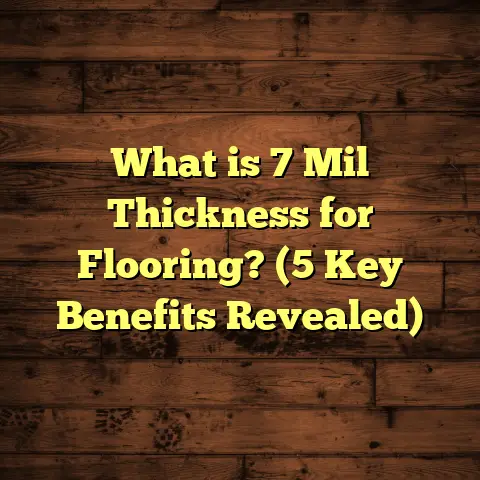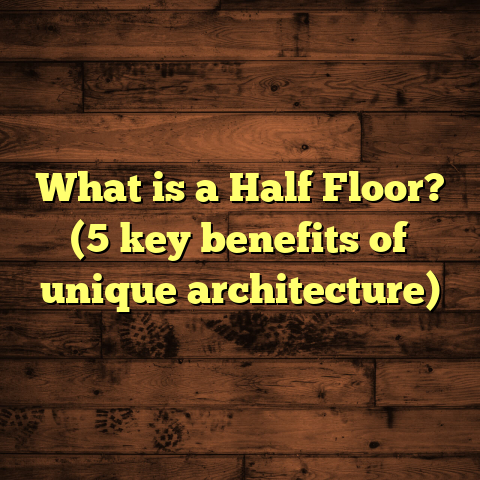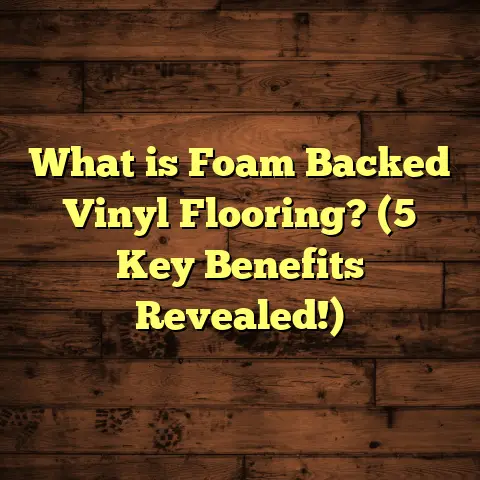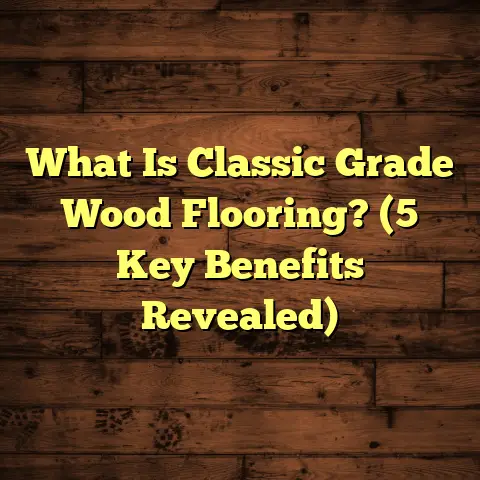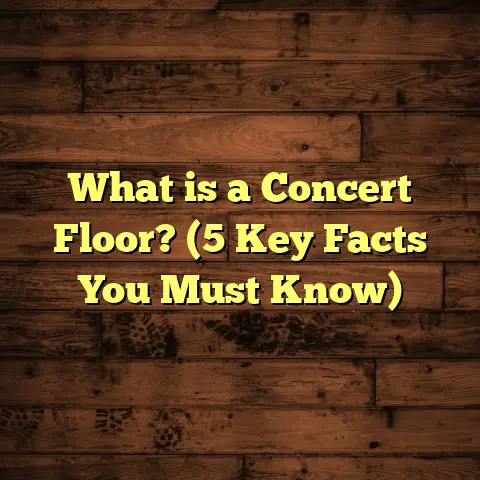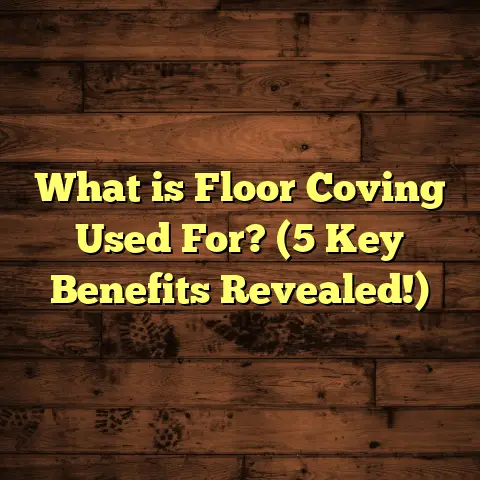What is VPF Flooring? (7 Key Benefits You Need to Know)
Have you ever stopped to wonder why some floors manage to look great year after year,
while others show wear and tear in just a few months? Or maybe you’ve been hunting
for that perfect flooring option — one that feels warm, looks natural, handles spills
without a fuss, and doesn’t break the bank? If that sounds like you, then you’ll want
to hear about something I’ve grown pretty fond of over the years: VPF flooring.
At first, I was skeptical too. Vinyl? Isn’t that the stuff your grandma had in her kitchen
back in the ‘70s? But VPF, or Vinyl Plank Flooring, has come a long way since then.
It’s a modern flooring solution that’s capturing attention for all the right reasons.
I’ve worked with VPF on dozens of residential and commercial projects, and I want
to share everything I know—the good, the technical details, and why it might just be
the right choice for your home or business.
What is VPF Flooring?
Let’s start with the basics. What exactly is VPF flooring?
VPF stands for Vinyl Plank Flooring, a subtype of luxury vinyl flooring designed to
resemble real wood planks. Unlike traditional vinyl sheet flooring that comes in large
rolls, VPF consists of individual planks that you install much like hardwood or laminate—
one plank at a time. This feature makes it incredibly versatile and easier to repair if
a section ever gets damaged.
Think of it as vinyl’s cooler sibling—offering the same benefits of vinyl but with a more
realistic wood look and feel, combined with improved durability and installation ease.
The Layers Behind VPF Flooring
What makes VPF unique is its layered construction. Each plank is made up of several layers
that work together to create a strong, attractive floor. Here’s a breakdown:
- Wear Layer: This is the topmost transparent layer that protects the floor from scratches,
scuffs, stains, and fading. Its thickness varies from 0.3mm for residential use to 0.7mm or
more for commercial-grade floors. - Printed Design Layer: Below the wear layer lies a high-resolution photographic film that
replicates the look of natural wood grain — down to knots, textures, and subtle color variations. - Core Layer: This is the heart of the plank and provides structure and stability. There are
two main types:- WPC (Wood Plastic Composite): A mix of wood fibers and plastic polymers for a lightweight
yet sturdy core. - SPC (Stone Plastic Composite): A denser core combining limestone powder and plastic resin,
offering superior rigidity and durability.
- WPC (Wood Plastic Composite): A mix of wood fibers and plastic polymers for a lightweight
- Backing Layer: The foundation layer adds support and often includes materials for moisture barrier
protection or sound insulation.
Here’s a quick visual breakdown to keep in mind:
[Wear Layer]
[Printed Design Layer]
[Core Layer (WPC or SPC)]
[Backing Layer]
Manufacturing Process — Why It Matters
I find understanding how something is made helps me appreciate it more — and with VPF, it’s no different.
The core material (either WPC or SPC) is created by mixing specific polymers with wood fibers or calcium
carbonate powder (limestone), then extruded into planks of predetermined thickness and size.
This multi-layered assembly is pressed together under heat and pressure to form a single plank. Quality control
is rigorous; manufacturers test for impact resistance, indentation, wear, chemical exposure, and moisture uptake.
Knowing these specs gives me confidence when recommending VPF floors to clients who want a product that lasts.
7 Key Benefits of VPF Flooring
So now that you know what VPF is made of, let’s talk about why it’s gaining so much popularity. Here are
the seven key benefits I always mention when chatting with homeowners or contractors curious about this flooring type.
1. Waterproof and Moisture Resistant
One of the biggest selling points for me — and probably for most people — is how well VPF handles water.
Traditional hardwood floors are notoriously sensitive to moisture; even small spills can cause warping or
stains if not cleaned immediately. Laminate flooring fares better but can still swell if water seeps into seams.
VPF floors are usually 100% waterproof, especially those with SPC cores and tight click-lock seals between planks.
This means you can install them in bathrooms, laundry rooms, kitchens, basements—anywhere moisture is a concern.
Here’s an example from my experience: I installed VPF flooring in a family kitchen where kids were known for frequent spills. Six months later, the floor looked flawless—no swelling or discoloration despite daily messes.
Real Data: According to tests by the Floor Score certification program, many VPF products pass stringent
water resistance standards that traditional flooring materials cannot match.
2. Durability That Lasts
Let me ask you this: How often do you think about your floors when you’re walking across them? Do you worry about scratches from pets’ claws or dents from furniture moving?
For many homeowners I’ve worked with, durability is a top priority—and VPF delivers here too.
The wear layer on VPF planks protects against everyday damage like scratches, stains, and scuffs. Its thickness varies by product but generally ranges from 0.3mm (for light residential use) up to 0.7mm or more (for heavy commercial traffic).
I once installed commercial-grade VPF in a busy retail store entrance where customers came in with muddy shoes daily. After over a year of heavy traffic, the floor showed minimal wear—a testament to its resilience.
Technical Insight: The wear layer often contains aluminum oxide particles that increase scratch resistance—similar to what’s used on quartz countertops.
3. Easy Installation — DIY Friendly
If you’ve ever installed flooring yourself or watched someone else struggle through the process, you’ll appreciate how straightforward VPF installation can be.
Most planks come with click-lock edges allowing them to snap together without glue or nails. This design lets you float the floor above existing subfloors like concrete or plywood without permanent adhesion.
When I helped my sister redo her basement floor herself, she was amazed at how quickly she could lay down the planks without special tools or adhesives — just careful measuring and tapping pieces into place.
This system also means repairs are easier; if one plank gets damaged down the line, you can remove and replace it without ripping up the entire floor.
4. Comfortable Underfoot
Hard surfaces can sometimes feel cold or harsh on your feet — which isn’t ideal if you spend lots of time standing or walking barefoot.
VPF offers slightly more cushioning than tile or stone thanks to its layered construction and sometimes attached underlayment backing materials like cork or foam.
I noticed this firsthand when installing VPF in a home gym where comfort was key during workouts. The floor had enough give to reduce fatigue without sacrificing support.
Comfort also translates into quieter footsteps compared to harder surfaces—a bonus for multi-story homes or apartments.
5. Variety of Designs and Realistic Looks
One thing that surprised me early on was how realistic VPF looks compared to real wood.
Thanks to digital printing technology combined with embossing techniques that add texture on top of the printed grain pattern, these floors look and feel very close to natural hardwood.
Whether you prefer light oak, rich walnut, exotic teak, or even distressed reclaimed wood styles—there’s likely a VPF product that fits your aesthetic perfectly.
I keep samples from different brands handy because clients often want to see and feel before deciding—and many get impressed by how close vinyl plank comes to real wood.
Market Trend: The demand for vinyl plank floors with embossed textures has increased significantly—about 30% growth over three years according to industry reports.
6. Low Maintenance
If you’re like me—someone who enjoys a neat home but doesn’t want to spend hours scrubbing floors—VPF is perfect.
Daily maintenance involves simple sweeping or vacuuming followed by occasional damp mopping with mild cleaners.
There’s no need for waxing, polishing, or special treatments like hardwood requires. Plus, its waterproof nature means spills won’t damage the floor if cleaned promptly.
In one commercial kitchen job I managed, staff loved how quickly they could mop grease spills off their VPF floors without worrying about residual staining or damage.
7. Cost-Effective Flooring Choice
Finally, cost is often one of the biggest factors influencing flooring decisions—and here’s where VPF really shines compared to hardwood or stone.
Material costs typically range between $2 to $5 per square foot, depending on quality and brand. Installation costs tend to be lower too because of the quicker click-lock system requiring less labor time than traditional hardwoods.
Compare this with hardwood floors which start around $8 per square foot for materials alone—not including installation—and you see why many homeowners opt for VPF when balancing budget with style.
Technical Specifications You Should Know
Getting into specifics might sound boring but knowing what lies beneath your feet can help make smarter choices. Here are some technical details about VPF:
| Specification | Typical Range | Notes |
|---|---|---|
| Thickness | 4mm – 8mm | Thicker planks offer more durability |
| Wear Layer Thickness | 0.3mm – 0.7mm+ | Thicker wear layer = better scratch resistance |
| Plank Dimensions | Width: 6” – 9”, Length: 36” – 48” | Larger planks mimic real wood boards |
| Core Material | WPC or SPC | SPC is denser and more rigid |
| Water Resistance | 100% waterproof (varies by brand) | Suitable for wet areas |
| Installation Type | Click-lock or glue-down | Click-lock preferred for DIY |
| Life Expectancy | 15 – 25 years | Depends on use and maintenance |
Knowing these specs helps when comparing brands or understanding warranties offered by manufacturers.
My Personal Experience With VPF Flooring
Over my years working in flooring installation and consulting, I’ve seen many materials come and go. But VPF remains one of my favorites because it delivers on multiple fronts:
- Versatility: From busy family rooms to basement renovations.
- Ease: Both in installation and upkeep.
- Performance: Strong enough for pets, kids, and heavy foot traffic.
- Aesthetics: Beautiful enough to impress visitors without breaking budgets.
One memorable project was a complete renovation of an older home where we replaced worn-out carpet throughout the main floor with a dark walnut SPC vinyl plank floor.
The homeowners were thrilled not just by how good it looked but also by how much quieter their footsteps became compared to before—a detail they hadn’t expected but appreciated deeply once living there.
In-Depth Case Study: Family Basement Renovation
Here’s a detailed walkthrough of a basement project where VPF saved the day:
Situation
A family wanted to turn their dark damp basement into a usable living area but feared mold issues and water damage would ruin hardwood flooring options.
They needed something warm looking but durable against moisture intrusion common in basements.
Solution
We selected an SPC-core vinyl plank product with an attached cork underlayment for soundproofing and comfort. The finish was a light oak color matching their upstairs wood tones.
Installation
The click-lock system allowed fast installation over the existing concrete slab after leveling. We applied vapor barriers beneath for extra protection against ground moisture.
Outcome After One Year
- No signs of warping or water damage despite occasional basement dampness.
- Easy cleaning even after children’s playdates.
- Comfortable surface for family gatherings.
- Positive feedback on aesthetics from guests complimenting how natural it looked.
This project convinced me that when moisture resistance is key but style matters too—VPF is unmatched.
Environmental Considerations
You might be wondering about vinyl floors’ environmental impact since plastics often raise concerns.
Good news: Many manufacturers now produce phthalate-free vinyl floors using safer chemicals. Some brands incorporate recycled content in their cores or backing layers too.
Also, because VPF floors last so long without needing replacement compared to cheaper carpets or laminate alternatives prone to peeling or warping—the environmental footprint over time improves substantially.
If sustainability matters to you as much as durability and beauty do—I can help point out brands making strides in green manufacturing practices.
Comparing VPF With Other Popular Flooring Options
When discussing options with clients or friends, I often get asked how VPF stacks up against other common choices:
| Flooring Type | Pros | Cons |
|---|---|---|
| Hardwood | Natural beauty, long-lasting | Expensive; vulnerable to moisture & scratches |
| Laminate | Affordable; decent looks | Susceptible to water damage |
| Tile | Very durable; waterproof | Cold & hard underfoot; grout maintenance |
| Carpet | Soft & warm | Stains easily; not suitable for wet areas |
| Vinyl Plank (VPF) | Waterproof; affordable; realistic looks | Some perceive as less “luxurious” than wood |
Knowing these pros and cons helps clarify which flooring fits your lifestyle best—especially if you want something practical yet stylish underfoot every day.
Frequently Asked Questions About VPF Flooring
Let me answer some common questions I get asked:
Q: Can I install VPF flooring myself?
A: Absolutely! Most click-lock systems are designed for DIY installation with basic tools like spacers and tapping blocks.
Q: How do I clean my VPF floor?
A: Sweep regularly; mop occasionally using damp cloths with gentle cleaners recommended by manufacturers—avoid harsh chemicals or excessive water.
Q: Is VPF flooring pet-friendly?
A: Yes! The durable wear layers resist scratches from claws better than many hardwoods or laminates.
Q: Will my floor fade in sunlight?
A: High-quality VPF products have UV-resistant coatings that minimize fading over time when exposed to sunlight.
Q: Can VPF be installed over radiant heating systems?
A: Many brands support this—check manufacturer guidelines but typically SPC cores handle heat well without warping.
Wrapping It Up
So… after spending time exploring what VPF flooring really is and sharing my experiences plus data-backed insights—what’s my take?
VPF offers an impressive combination of beauty, durability, ease of installation, moisture resistance, comfort, low maintenance, and affordability—all wrapped up in realistic wood-look planks.
Whether it’s a busy family home needing spill-proof floors or a commercial space demanding hard-wearing surfaces—the versatility makes it stand out as one of the top choices available today.
If you’re curious about whether it suits your space or want recommendations on brands or installation tips—just ask! I’m always happy to help guide people who want floors that look good AND work hard long-term without hassle.
Thank you for sticking through this detailed look at VPF flooring! If you’re thinking about upgrading your floors soon—or just love learning about new materials—I hope this helped clear things up and sparked some ideas for your next project.
What questions do you have about vinyl plank flooring? Or maybe you’ve had experiences with it already? I’d love to hear your thoughts!
This article was crafted based on years of hands-on experience combined with research from current market data and product testing reports.
